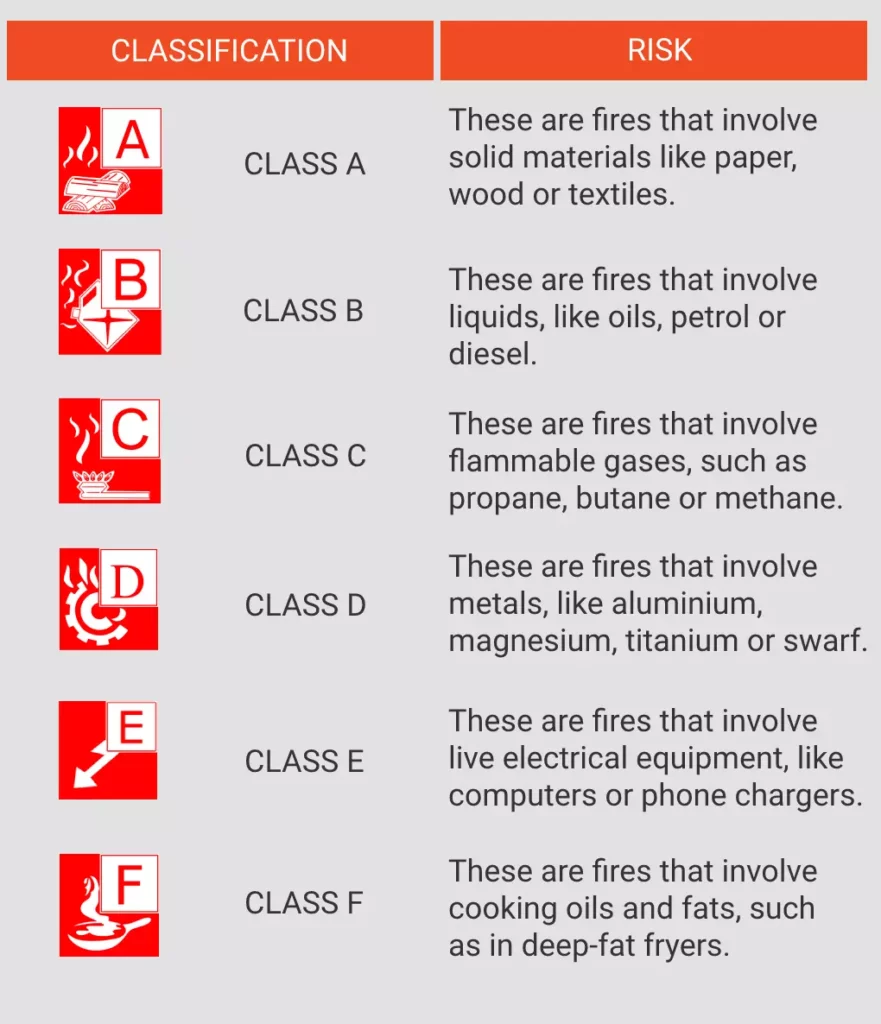What are the 6 classes of fire?
In order to establish the best way to extinguish a fire, it is important to know what type of fire it is. There are six major classes of fire, all differentiated by what is fuelling it. So what is the difference of classes of fire?

As outlined in the diagram above, the different classes of fire are categorised into six different classes consisting of:
Class A: these are fires that involve solid materials like paper, wood or textiles.
Class B: these are fires that involve liquids, like oils, petrol or diesel.
Class C: these are fires that involve flammable gases, such as propane, butane or methane.
Class D: these are fires that involve metals, like aluminium, magnesium, titanium or swarf.
Class E: these are fires that involve live electrical equipment, like computers or phone chargers.
Class F: these are fires that involve cooking oils and fats, such as in deep-fat fryers.
Each different class of fire will need to be treated in a different way, so it is important to know the difference of classes of fire.
Colour coding of Extinguishers
There are many different types of fire extinguisher, each using a different substance to put out the fire. It is vital that you use the correct type of fire extinguisher for the specific class of fire, as using the wrong one could make the problem much worse and cause severe harm. For example, using a water extinguisher on an electrical fire could cause an electric shock, and water on a metal fire could cause an explosion.

The different types of extinguisher are colour-coded, so in an emergency it is easy to recognise which one to use. They are as follows:
Red
These are water based. There are four different types of ‘Red’ extinguisher: water spray, water mist (or fog), water jet or water with additives, which each serve a slightly different purpose.
These are generally cheaper options, but it is only advisable to use these on Class A fires – those fuelled by solid materials.
Cream
These are foam extinguishers, and are most suited to putting out liquid fires, such as oil or petrol. They work by sealing the surface of the liquid, which prevents flammable vapour reacting with the oxygen in the air – thus starving the fire of fuel. Cream Extinguishers can also be used for Class A fires.
Blue
These are powder extinguishers – either dry powder or L2 & M28 powder. Dry powder extinguishers are very versatile, and can be used on Class A, B and C fires, as well as electrical but they don’t cool so there is a chance that it could reignite. L2 & M28 extinguishers are best used for Class D – metal fires.
Powder extinguishers can cause breathing problems, and impair visibility, so they are not advised for indoor use unless there is no alternative.
Black
Carbon dioxide extinguishers. These are most commonly used for electrical fires, so will often be found in offices. They don’t leave any residue, and work by covering the fire, again to cut off the oxygen supply.
Black extinguishers can also be used on Class B fires.
Yellow
A yellow label denotes a Wet Chemical extinguisher. They work best on Class F fires, by rapidly knocking out the flames, before cooling and then reacting with the oil to form a soapy solution. They can also be used for Class A fires.
The Aftermath of a Fire
A fire can be an incredibly upsetting event in anyone’s life. Unfortunately, even once the fire has been extinguished, there are still plenty of problems that you will need to address, and as soon as possible.
The longer that it is left, the secondary consequences of a fire begin to take hold – paint and fibreglass will yellow, metal can corrode and rust and clothing can start to stain. The acidic nature of soot also has potentially serious health effects – it can be particularly harmful to children and the elderly.
Soot can contain dangerous chemicals and acids which, due to its minute size, can get into people’s airwaves. This has been known to cause asthma and even some cancers – to put it simply, you need to thoroughly clean the entire area after a fire.
Our Services
If you have experienced some significant fire and require a comprehensive fire damage cleanup we can help you. We can adapt our services to provide you with the care that you need. We understand that quick action is imperative in these situations, so we can be onsite ASAP.
Our experienced technicians use the best methods and equipment for removing soot and ash, which will prevent them causing further damage. We use HEPA rated filtration equipment to make sure that all of the soot and ash particles are completely removed from the building, as opposed to just being redeposited elsewhere. We will even strip out areas when required, before cleaning and restoring them with minimal disruption.
We can also tackle smoke damage, using a wide range of methods that will suit the various types of fire and damage. We are acutely aware that fires can leave an awful odour, so we fully eradicate these smelly micro-organisms using our unique BIOSWEEP® system. Read how we helped a convenience store in Wickham after a fire to find out more about our service.
If you have suffered from a fire, please get in touch to learn how we can help to get your property look, and smell, back to normal.



